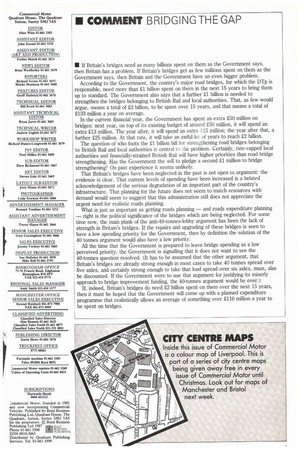• COMMENT BRIDGING THE GAP
Page 7

If you've noticed an error in this article please click here to report it so we can fix it.
• If Britain's bridges need as many billions spent on them as the Government says, then Britain has a problem. If Britain's bridges get as few millions spent on them as the Government says, then Britain and the Government have an even bigger problem.
According to the Government, the country's major road bridges, for which the DTp is responsible, need more than El billion spent on them in the next 15 years to bring them up to standard. The Government also says that a further 21 billion is needed to strengthen the bridges belonging to British Rail and local authorities. That, as few would argue, means a total of E2 billion, to be spent over 15 years, and that means a total of £133 million a year on average.
In the current financial year, the Government has spent an extra 250 million on bridges: next year, on top of its existing budget of around E50 million, it will spend an extra £13 million. The year after, it will spend an extra e15 million; the year after that, a further 225 million. At that rate, it will take an awful lot of years to reach E2 billion.
The question of who foots the El billion bill for strengthening road bridges belonging to British Rail and local authorities is central to the problem. Certainly, rate-capped local authorities and financially-strained British Rail will have higher priorities than road bridge strengthening. Has the Government the will to pledge a second El million to bridge strengthening? On past experience it seems unlikely.
That Britain's bridges have been neglected in the past is not open to argument: the evidence is clear. That current levels of spending have been increased is a belated acknowledgement of the serious degradation of an important part of the country's infrastructure. That planning for the future does not seem to match resources with demand would seem to suggest that this administration still does not appreciate the urgent need for realistic roads planning.
What is just as important as getting roads planning — and roads expenditure planning — right is the political significance of the bridges which are being neglected. For some time now, the main plank of the anti-40-tonnes-lobby argument has been the lack of strength in Britain's bridges. If the repairs and upgrading of these bridges is seen to have a low spending priority for the Government, then by definition the solution of the 40 tonnes argument would also have a low priority.
All the time that the Government is prepared to leave bridge spending as a low perceived priority, the Government is signalling that it does not want to see the 40-tonnes question resolved. (It has to be assumed that the other argument, that Britain's bridges are already strong enough in most cases to take 40 tonnes spread over five axles, and certainly strong enough to take that load spread over six axles, must, alas be discounted. If the Government were to use that argument for justifying its miserly approach to bridge improvement funding, the 40-tonnes argument would be over.) If, indeed, Britain's bridges do need E2 billion spent on them over the next 15 years, then it must be hoped that the Government will come up with a planned expenditure programme that realistically allows an average of something over £110 million a year to be spent on bridges.






















































































